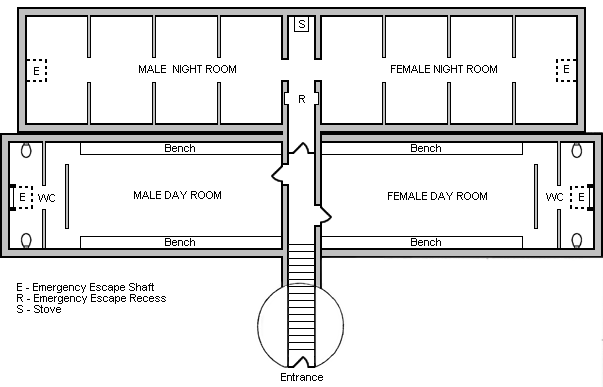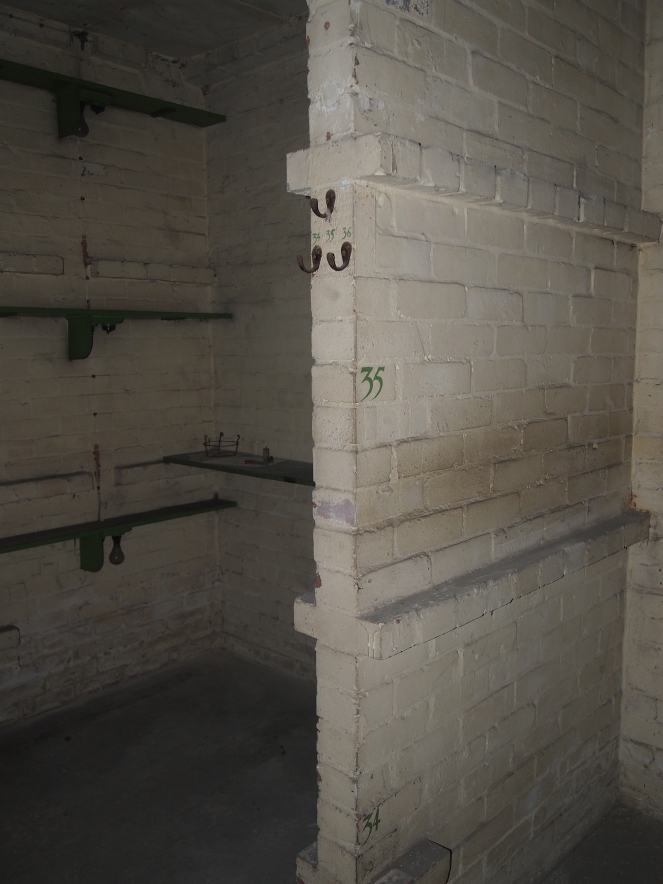The period between the two World Wars was one of massive expansion for London. The city’s population grew and grew, peaking at 8.6 million in 1939 (a total not surpassed until very recently), and new housing was built at a rate never seen before to accommodate this growth. These new homes, council houses and private houses alike, contained modern facilities such as indoor toilets, making them attractive to those living in older, less well-equipped homes. But a new housing development in East Sheen, in south west London, had yet another desirable feature for potential buyers: as the fear of war grew in the 1930s, St Leonard’s Court came with its own purpose-built air raid shelter.

By the mid-1930s, the rise of Hitler and Nazi Germany fulled fears that Europe would soon be plunged into conflict. Many Londoners remembered the terrifying Zeppelin and Gotha air raids on London during the First World War, and advances in aviation meant that aerial bombardment would once again threaten the city in the event of war. Even before the war was declared in September 1939, measures were being put in place to protect the inhabitants of Britain’s major cities and industrial centres from air raids.
Work began on the development at St Leonard’s Court in the mid-1930s. It’s thought that the bomb shelter was constructed in 1938, as the flats themselves were nearing completion. The flats in the mansion block, developed by Mr Fox, a local builder, were conveniently located close to Mortlake mainline station, and just round the corner from local shops. The addition of a private air raid shelter was just another attraction of a well-appointed, modern block of flats.
Unlike older buildings (including older mansion blocks such as that featured in this post about a bomb shelter in central London), St Leonard’s Court did not have cellars where residents could take refuge during air raids. A private shelter meant that residents knew they had a place to go in the event of an air raid, and perhaps to the more snobbish, having a private shelter meant that they wouldn’t have to “slum it” in a public shelter. Perhaps to some, the idea of a purpose-built bomb shelter was more reassuring than a makeshift shelter in a cellar or basement. However, as we’ll see, a private, purpose-built shelter did not mean that it was a luxurious place to sit out the air raids.
The entrance to the shelter is through a little turreted building directly opposite the entrance to some of the flats.


Down a steep, narrow flight of stairs the shelter opened up – four rooms, two on either side of a central corridor. The shelter was segregated along gender lines, with men occupying one side of the shelter and women the other side.

Men and women had a day room, with benches along the walls, functional spaces where people would have waited for the all-clear. It can’t have been a pleasant place to be, sitting next to and opposite your neighbours in the middle of the night, listening to the bombs falling. Although perhaps there were lighter moments too, sing-songs or funny stories to take people’s minds off the bombs. Behind the wall at the back of each room – where the people in the photo below are looking – was a pair of chemical toilets and an emergency exit.


Night rooms contained numbered bunks, with each alcove containing three bunks. Today, you can still see the shelves and ledges where the beds would have been, and little numbered hooks remain on the walls where people in the shelter would have hung their coats before climbing into the bunks. The shelter was heated by a stove, but I wouldn’t have been surprised if many people kept their coats on, even in bed.

St Leonard’s Court is made up of 83 flats, but the air raid shelter was only built to accomodate 45 people. It’s unlikely that all of the flats were occupied during the war, but nevertheless a rota system was in place which allocated residents a place in the shelter on some nights, but not others. On a night where a resident might not have been allocated a space in the shelter, they would either have had to stay in their flat, or seek shelter elsewhere. That being said, interviews with people who lived in St Leonard’s Court during the war found that some people found the bomb shelter to be so unpleasant that they preferred to take a risk and stay in their own flat during an air raid!

The shelter meant that those inside were safe from the dangers of shrapnel and falling masonry – plus, even if one’s own home was not hit, bombs falling nearby could blow out windows, scattering deadly shards of glass. Inside the shelter, people were safe from all of this. There were even alternative exits, above the toilet blocks, where people could escape if the main entrance to the shelter was damaged or blocked.

However, the occupants of the shelter would not be safe if the shelter received a direct hit. The shelter is not completely underground – the lawn above it shows that the top of the shelter is a few feet above the surrounding ground.

In November 1940, a direct hit on a similar shelter at nearby Sheen Court killed nine people. There are so many harrowing tales from the Second World War of shelters being hit and the people in them losing their lives. A detailed map of the bombs that fell on the Borough of Barnes (which East Sheen was then a part of) shows that an air raid in September 1940 killed 16 people in a public shelter on Trinity Church Road, in north Barnes.
As the pictures in this post demonstrate, the shelter at St Leonard’s Court is intact, with many original features remaining despite it being out of use for 70 years. A few years ago plans were made for it to be replaced with more housing, but the shelter was saved and the structure has been Grade II listed by Historic England, although it also currently appears on the Heritage at Risk list due to “slow decay”. However, in 2014 work began to restore the shelter and make it safe for public access, with the intention of making it a valuable educational resource for local schools. Made safe and restored to how it would have looked and felt during the war, the shelter at St Leonard’s Court provides a tangible link to the Blitz that becomes more and more important as the Second World War begins to pass out of living memory.
I visited the air raid shelter at St Leonard’s Court during the Open House London weekend in September 2015.
References and further reading
Restoration project: the Air Raid Shelter at St Leonard’s Court, Mortlake and East Sheen Society http://mess.org.uk/projects/
Barnes, Mortlake and East Sheen – Second World War Bombs map http://www.barnes-history.org.uk/Bombmap/mappage.html
St Leonard’s Air Raid Shelter, East Sheen, Environment Trust for Richmond-upon-Thames http://ww.environmenttrust.co.uk/projects/historic-and-built-environment/269-air-raid-shelter.html
Historic England Heritage at Risk list – Air Raid Shelter, St Leonard’s Court, St Leonard’s Road, East Sheen SW14 – Richmond upon Thames http://risk.historicengland.org.uk/register.aspx?id=50199&rt=1&pn=1&st=a&di=Richmond+upon+Thames&ctype=all&crit=
Listed Air Raid Shelter in East Sheen getting restoration for education – This is Local London, 27th May 2014 http://www.thisislocallondon.co.uk/news/11234172.Listed_air_raid_shelter_getting_restoration_for_education/


A fascinating place. This is somewhere that, at this particular time, deserves to be preserved and maintained.
LikeLike
Reblogged this on First Night History and commented:
I had to reblog this post, not least because we were living in East Sheen until recently and I had no idea of the air raid shelter’s existence. I’ve just discovered, however, that my other half knows all about it and many years ago he was able to go down there. Fascinating and I’m so relieved the structure has been restored and listed.
LikeLike
Grim. There was an air raid shelter on Kennington Common which had a direct hit…
LikeLike
There were a couple in Lewisham too – one just outside M&S, the other in Albion Way, interesting piece Caroline.
LikeLike
You may find this wonderful blog interesting: https://subterraneangreenwich.wordpress.com
LikeLike